I have been trying to figure out my mistake in the Sudoku backtracking solver for three days. The problem is from leetcode Sudoku Solver.
My solver is based on the deduction in the attached picture. The problem is that my board is changed even if a path from root to leaf is invalid.
In other words, after it goes through an invalid path, the values it attempted are fixed in my original board. However, I only update my original board when its children returns true ( see the part in helper method: // put a number and generate children).
Basically, for each '.', I generate all possibilities from 1 to 9, construct a temp board which fills the current '.' with one possibility, then call helper of the next '.' with temp board. I know it is not good to store a same size boardTemp for each possible child because of space cost, but my main concern now is to solve the problem first before optimizing the cost.
All in all, why is my board changing even if all children is not valid?
For example, base on the initial board
..9748...; 7........; .2.1.9...;
..7...24.; .64.1.59.; .98...3..;
...8.3.2.; ........6; ...2759..;
I got the final result after I run:
139748652; 745326189; 826159437;
35769.24.; .64.1.59.; .98...3..;
...8.3.2.; ........6; ...2759..;
public void sudokuSolver(char[][] board) {
for (int i = 0 ; i < board.length ; i++) {
for (int j = 0 ; j < board.length ; j++) {
if (board[i][j] == '.') {
// find the first '.' as root
helper(i, j, board);
return;
}
}
}
}
private boolean helper(int row, int col, char[][] board) {
// case 2. check if it has following '.' and store its position
boolean hasNext = false;
boolean nextSearching = false;
int nextRow = row;
int nextCol = col;
for (int i = 0 ; i < board.length ; i++) {
for (int j = 0; j < board.length ; j++) {
if (nextSearching && !hasNext && board[i][j] == '.') {
hasNext = true; // there is next!
nextRow = i;
nextCol = j;
}
if (i == row && j == col) {
nextSearching = true;
}
}
}
// exit condition: last '.'
if (!hasNext) {
for (char put = '1' ; put <= '9' ; put ++) {
if (isValid(row, col, board, put)) {
return true;
}
}
return false;
}
// put a number and generate children
for (char put = '1' ; put <= '9' ; put ++) {
if (isValid(row, col, board, put)) {
char[][] boardTemp = board;
boardTemp[row][col] = put;
boolean valid = helper(nextRow, nextCol, boardTemp);
if (valid) {
// board is supposed to change only when valid is true.
board[row][col] = put;
return true;
}
}
}
return false;
}
private boolean isValid(int row, int col, char[][] board, char c) {
// go through each row, column, and subblock to determine if c is a valid choice based on current board.
for (int jCol = 0 ; jCol < 9 ; jCol ++) {
if (board[row][jCol] == c) {
return false;
}
}
for (int iRow = 0 ; iRow < 9 ; iRow ++) {
if (board[iRow][col] == c) {
return false;
}
}
for (int i = row/3*3 ; i < row/3*3 + 3 ; i++) {
for (int j = col/3*3 ; j < col/3*3 + 3 ; j++) {
if (board[i][j] == c) {
return false;
}
}
}
return true;
}
